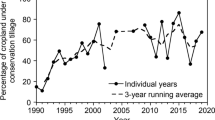Abstract
The relationship between total phosphorus retention, landscape position of wetlands, and surrounding land-use patterns was explored with the goal of identifying easily determined landscape parameters as indicators of a wetland’s role in water quality maintenance. Sediment cores were collected from 14 wetland sites chosen to represent a range of wetland types, wetland position, and surrounding land-use patterns in a small coastal Virginia watershed. Sediment accumulation rates and total phosphorus retention rates were analyzed using137Cs dating and acid extraction techniques. Both sediment accumulation rates and total phosphorus retention rates were found to be comparable to previously reported values for similar wetland types. The landscape analysis did not support the hypothesis that total phosphorus retention would vary with landscape setting and/or wetland type. The wetlands sampled may represent landscape parameters too similar to detect any significant differences. Alternatively, the findings may indicate that in small coastal watersheds, most wetlands perform total phosphorus retention functions to the same level. The management implications of this latter conclusion may be that headwater wetlands are particularly important for water quality functions.
Similar content being viewed by others
Literature Cited
Allen, S.E., H.M. Grimshaw, J.A. Parkinson, and C. Quarmby. 1974. Chemical Analysis of Ecological Materials. John Wiley and Sons, New York, NY, USA.
Aspila, K., H. Agemian, and A. Chau. 1976. A semi-automated method for the determination of inorganic, organic and total phosphate in sediments. Analyst 101:187–197.
Beulac, M.N. and K.H. Reckhow. 1982. An examination of land use nutrient export relationships. Water Resources Bulletin 18:1013–1023.
Cowardin, L.M., V. Carter, F.C. Golet, and E.T. LaRoe. 1979. Classification of Wetlands and Deepwater Habitats in the United States. U.S. Fish and Wildlife Service, Washington, DC, USA. FWS/OBS-79/31.
Craft, C.B. and C.J. Richardson. 1993. Peat Accretion and N, P and organic C accumulation in nutrient enriched and unenriched everglades peatlands. Ecological Applications 3:446–458.
Detenbeck, N. E., C.A. Johnston, and G.J. Niemi. 1993. Wetland effects on lake water quality in the Minneapolis/St. Paul metropolitan area. Landscape Ecology 8:39–61.
Folk, R.I. 1980. Petrology of Sedimentary Rocks. Hemphill Publishing Company, TX, USA.
Golley, F.B. 1988. Introducing landscape ecology. Landscape Ecology 1:1–3.
Heliotis, F.D. and C.B. DeWitt. 1983. A conceptual model of nutrient cycling in wetlands used for wastewater treatment: a literature analysis. Wetlands 3:134–152.
Holdahl, S.R. and N.L. Morrison. 1974. Regional investigations of vertical crustalrelevelings and mareograph data. Tectonophysics 23:373–390.
Horton, T. and W.M. Eichbaum. 1991. Turning the Tide: Saving the Chesapeake Bay. Island Press, Washington, DC, USA.
Khan, H. and G. Brush. 1994. Nutrient and metal accumulation in a freshwater tidal marsh. Estuaries 17:345–360.
Kratz, T.K., B.J. Benson, E.R. Blood, G.L. Cunningham, and R.A. Dahlgreen. 1991. The influence of landscape position on temporal variability in four North American ecosystems. American Naturalist 138:355–378.
Mitsch, W.J. and J.G. Gosselink. 1993. Wetlands. Van Nostrand Reinhold Company, New York, NY, USA.
Nichols, D. S.. 1983. Capacity of natural wetlands to remove nutrients from wastewater. Journal of the Water Pollution Control Federation 55:495–505.
Peterjohn, W.T. and D.L. Correll. 1984. Nutrient Dynamics in an Agricultural Watershed: Observations on the role of a Riparian Forest. Ecology 65:1466–1475.
Rast, W. and G. Lee. 1983. Nutrient Loading Estimates for Lakes. Journal of Environmental Enginering, ASCE 109:502–517.
Richardson, C. 1985. Mechanisms controlling phosphorus retention capacity in freshwater wetlands. Science 228:1424–1427.
Risser, P.G. 1987. Landscape ecology: state of the art. p. 3–14.In M.G. Turner (ed.) Landscape Heterogeneity and Disturbance. Springer-Verlag Company, New York, NY, USA.
SAS Institute Inc. 1985. SAS User’s Guide: Statistics. Version 5 Edition. Cary, NC, USA.
Stevenson, C.L., L.G. Ward, and M.S. Kearny. 1986. Vertical accretion in marshes with varying rates of sea level rise. p. 241–259.In D.A. Wolfe (ed.) Estuarine Variability. Academic Press, New York, NY, USA.
Walbridge, M.. 1991. Phosphorus avaialability in acid organic soils of the lower North Carolina coastal plain. Ecology 72:2083–2100.
Author information
Authors and Affiliations
Rights and permissions
About this article
Cite this article
Greiner, M., Hershner, C. Analysis of wetland total phosphorus retention and watershed structure. Wetlands 18, 142–149 (1998). https://doi.org/10.1007/BF03161451
Received:
Revised:
Accepted:
Issue Date:
DOI: https://doi.org/10.1007/BF03161451




